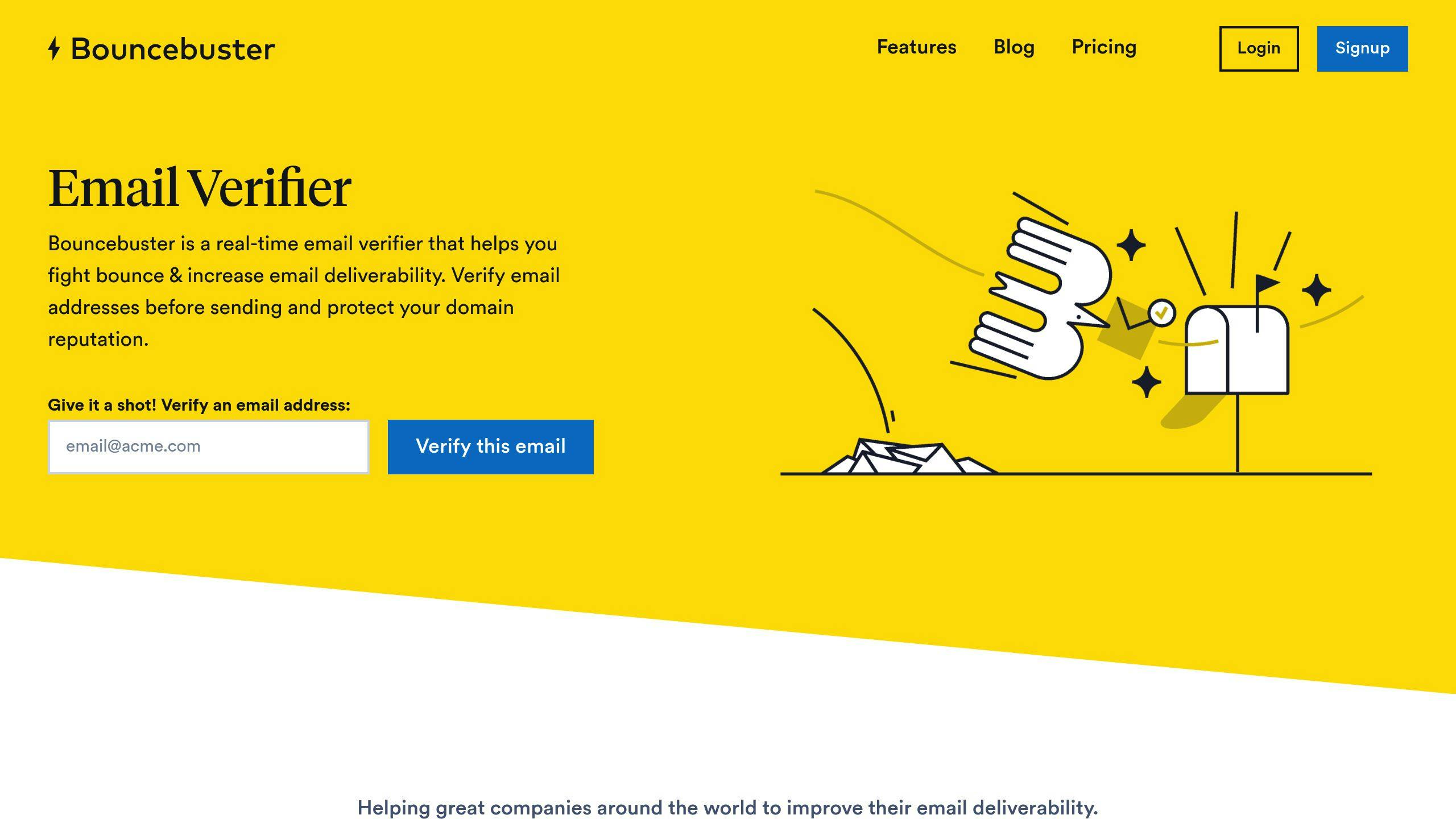Proper email validation is crucial for maintaining your sender reputation and improving the success of your email campaigns. Invalid emails can lead to high bounce rates, wasted resources, and even damage to your domain’s credibility. Here’s a quick overview of how to validate emails effectively:
- Regex for Syntax Checks: Use simple patterns like
^[^\s@]+@[^\s@]+\.[^\s@]+$to catch basic formatting errors. - Avoid Overly Strict Regex: Over-complicated patterns can block valid emails with special characters or international formats.
- Clean Input First: Trim whitespace, standardize case, and sanitize inputs to reduce errors.
- Go Beyond Regex: Combine syntax checks with domain verification, MX record checks, and real-time validation tools for better accuracy.
Regex is a great starting point, but it can’t confirm if an email exists. Pair it with domain and SMTP verification to ensure deliverability and keep your email lists clean.
Understanding How Email Validation Regex Works
What Makes an Email Address Valid
Email addresses follow a structure outlined by RFC 5322 standards. A valid email includes three main parts:
- Local part: The section before the
@symbol (e.g.,username,firstname.lastname). - @ symbol: Acts as the separator.
- Domain part: Includes the domain name and top-level domain (e.g.,
company.com).
These standards allow for more complexity than you might expect. For example, email addresses can include special characters, subdomains, or even IP addresses. This complexity is why understanding the structure is crucial when creating regex patterns to validate email syntax.
Common Regex Patterns for Email Syntax
Regex patterns for email validation can vary from simple to more flexible, depending on your requirements. Here are two examples:
// Basic pattern for common email formats
^[^\s@]+@[^\s@]+\.[^\s@]+$
// More flexible pattern allowing special characters
^[a-zA-Z0-9.*%±]+@[a-zA-Z0-9.-]+\.[a-zA-Z]{2,}$
"Strict regex can reject valid email addresses, potentially turning away customers." – Nikl, Developer, dev.to [6]
Why Overly Complex Patterns Can Be a Problem
Using regex that’s too strict can create unnecessary issues. For instance, it might reject valid emails with plus signs, multiple dots, or even IP addresses. This can lead to:
- False negatives: Legitimate emails, especially international ones, being flagged as invalid.
- Missed opportunities: Blocking potential users from signing up or subscribing.
- Frustrated users: Annoying people with unnecessary validation errors.
The key is to strike a balance between accurate validation and user convenience. Regex is great for checking syntax, but combining it with methods like domain verification or real-time validation ensures a smoother experience.
Best Practices for Using Regex in Email Validation
Use Simple and Effective Patterns
When using regex for email validation, keeping it straightforward is key. A simple pattern like ^[^\s@]+@[^\s@]+\.[^\s@]+$ works well for most standard email formats without adding unnecessary complexity [1]. This type of pattern avoids rejecting valid email addresses that might include special characters or uncommon formats.
Here’s what to focus on:
- Check for multiple
@symbols to ensure proper structure. - Validate the domain’s format and structure.
- Support international character sets where applicable.
- Strike a balance between flexibility and security.
Clean and Sanitize User Input
Before applying regex, make sure the input is clean and properly formatted. This step reduces validation errors and helps mitigate security risks. Sanitizing user input is essential for both accuracy and safety.
| Sanitization Step | Purpose | Implementation |
|---|---|---|
| Trim whitespace | Remove extra spaces at the beginning or end | Use built-in trim functions |
| Convert to lowercase | Standardize inputs for consistent validation | Apply the toLowerCase() method |
| Remove special characters | Prevent security risks like cross-site scripting (XSS) | Strip unnecessary characters |
| Check input type | Ensure the data is a string | Validate the data type first |
This step-by-step process ensures cleaner input and reduces the chances of errors or vulnerabilities [1].
Test Patterns with a Variety of Cases
Testing is crucial to ensure your email validation works effectively. Build a test suite that includes a variety of email formats, such as:
- Standard formats (e.g., [email protected])
- Addresses with subdomains or periods (e.g., [email protected], [email protected])
- Addresses with international characters or less common top-level domains
Regular testing helps refine your regex patterns, reducing both false positives and false negatives [3]. While regex is excellent for checking syntax, it’s not enough on its own. Pair it with other methods like real-time email verification services. These can validate domain existence and MX records, offering a more reliable solution for managing email lists.
sbb-itb-f42cab2
Email RegEx Pattern Tutorial
Why Regex Alone Is Not Enough
Regex is great for checking if an email address follows the correct format, but it can’t confirm if the email actually exists or can receive messages. To build accurate email lists, you need more than just regex.
Check Domains and MX Records
Verifying domains and MX (Mail Exchange) records gives insights into whether an email address can receive messages – something regex can’t do. Here’s a breakdown:
| Verification Type | Purpose |
|---|---|
| Domain Verification | Ensures the domain is valid and active |
| MX Record Check | Confirms the domain is set up to receive emails |
This process helps identify invalid addresses early, keeping your email list clean and protecting your sender reputation [2].
Use Real-Time Email Verification Tools
Real-time email verification tools go beyond what regex offers. They perform advanced checks like SMTP verification, detecting catch-all domains, and spotting disposable email addresses. These tools streamline the process and reduce bounce rates.
Benefits include:
- Advanced validation beyond format checks
- Automation for handling large email lists
- Better email delivery rates
- Avoiding risky or invalid addresses
"Combining regex with domain and MX record verification ensures that email addresses are not only syntactically correct but also deliverable. This reduces the risk of sending emails to non-existent or undeliverable addresses, which can harm email deliverability rates and domain reputation" [5][3].
Tools like Bouncebuster integrate these features via API, simplifying email validation and ensuring your lists are reliable [5].
Conclusion: Tips for Better Email Validation
Key Points for Using Regex Effectively
A simple regex pattern, such as /^[^s@]+@[^s@]+.[^s@]+$/, can handle most email validation tasks effectively [4]. The challenge lies in balancing thorough validation with ease of use for your users.
Here are a few things to keep in mind when working with regex for email validation:
| Validation Aspect | Best Practice | Common Pitfall to Avoid |
|---|---|---|
| Pattern Complexity | Stick to straightforward and functional patterns | Avoid overly strict rules that block valid emails |
| Input Handling | Sanitize and clean user input | Ignoring special characters or international formats |
| Testing Strategy | Test with a variety of email formats | Relying only on standard email formats for testing |
While regex is a great starting point, it does have its limits. To cover all bases, advanced tools can take your validation efforts further.
How Tools Like Bouncebuster Can Help

Regex focuses on email syntax, but for a more complete solution, tools like Bouncebuster offer additional features:
- Real-time verification to detect invalid emails instantly
- Bulk verification for processing multiple addresses at once
- REST API support for seamless integration with your systems
- Filters for disposable email addresses and catch-all domains



